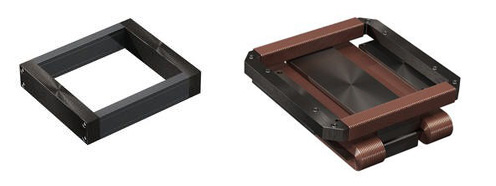Alignment Manets
Alignment magnets are used to provide uniform fields across a substrate. These fields are used to coerce magnetically permeable materials into a preferred orientation. Alignment may occur either in process, or as a post process operation as is the case with annealing magnets.
Now alignment magnets was designed as small as 10 lbs and as large as 10,000 lbs. During the design, magnetic circuits of a specified topology are configured to precisely control the magnetic field shape, magnitude, and uniformity of the device. These output characteristics are all critical to the final performance of the product being processed.
To verify final performance, manufacturers serializes and magnetically maps each device

Types
• Annealing
• Electroplating
• Sputtering
Annealing
Some products require post process orientation of grains in order to achieve full functionality. These post processes usually occur at elevated temperatures to allow granular motion. By exposing the product to a magnetic field while at elevated temperatures, the grains are free to align themselves with the magnetic flux lines. Keeping the product exposed to the magnetic field during the cooling cycle pins the domains in a preferred orientation. These types of magnets are typically external to the annealing oven, but can be placed within them utilizing proper material selections. These magnets can either be permanent, electromagnet, or superconducting depending on the field requirements and degree of adjustability required. Precision Magnetech is in permanent and electro-magnets. Applications requiring superconducting versions are not supported. As such, fields in these devices are typically limited to 1 Tesla.
When used external to annealing ovens, thermal exposure must also be considered as significant heat can be transmitted from the oven to the magnet. Proper insulation or spacing of the magnet is recommended.
Electoplating
Frequently, Permalloy films are electroplated onto a wafer during the manufacturing process of read/write heads. Alignment of the Permalloy grains is critical to proper functionality of the final product. By exposing the wafer to a magnetic field while in the plating bath, the grains are free to align themselves with the magnetic flux lines. When removed from the plating bath, the film characteristics are pinned in a preferred direction of orientation
These types of magnets are installed external to the plating bath. These magnets can either be permanent or electromagnet depending on the field requirements and degree of adjustability required. Fields in these devices are typically limited to 1 Tesla.
As a result of the plating environment, these magnets can be exposed to corrosive elements. Proper plating and shielding of the magnets is critical to longevity of performance.
Sputtering
In process grain alignment of sputtered films can be critical to final performance of a product. During the thin film deposition process, magnetically permeable materials are deposited onto a substrate. If the sputtered atoms are exposed to a magnetically biased field during deposition, grain growth preferentially aligns with the magnetic flux lines. Upon solidification, the film characteristics are pinned in a preferred direction of orientation.
These types of magnets can be found either external to, or within sputter deposition system. These magnets can either be permanent or electromagnet depending on the field requirements and degree of adjustability required. Fields in these devices are typically limited to .1 Tesla.
As a result of the sputtering process, magnets located within the vacuum chamber typically require hermetic sealing to guarantee compatibility. Electromagnets found within the vacuum chamber typically require active cooling to assure thermal control over Ohmic losses that are occurring in the convection free environment.
1, Help us designs
We do not make Alignments; we make the magnetic assemblies that enable these devices to operate effectively. In order to make a perfect magnet assembly, we would need to know the following
1.Is a permanent magnet or electromagnet solution preferred?
a. If electromagnet, has a power supply already been selected?
i. If so, what are its specifications (Power, Current, Voltage)?
2. What is the size of the volume or area you are looking to align?
3. What field strength do you required over that volume/area?
4. What field uniformity do you require over that volume/area?
5. What is the maximum skew required over that volume/area?
6. What are the maximum weight and size limitations of the magnet?
7. Will the alignment magnet be inside of a vacuum?
8. What temperature range will the alignment magnet work within?
9. Will the alignment magnet be submersed in a fluid?
10. How will the alignment magnet be integrated into your system?
11. How will the alignment magnet be integrated into your system?
a. Beneath/above a tank or oven
i. If beneath/above, how high or below the active volume/area?
b. Around a tank or oven
ii.If around, what size vessel must the magnet accommodate?
2, Materials
Electromagnets
1. Copper Wire (insulation application dependent)
Permanent Magnets
1. Nd-Fe-B – Highest Strength/volume, moderate cost., moderate temperature extremes (150°C),
2. Sm-Co – High Strength/volume, highest cost, high temperature extremes (300°C)
3. Ceramic – Low Strength/volume, lowest cost, high temperature extremes (300°C)
4. Alnico – Moderate to High Strength/volume, high cost, highest temperature extremes (450°)
Frame Materials
1. Carbon Steels (1010, 1045) – high saturation flux, low cost, poor corrosion resistance
2. Martensitic Stainliess Steels (416, 430) – moderate-high saturation flux, moderate cost, good corrosion resistance
3. Nickel Super Alloys (Hiperco®) – highest saturation flux, highest cost, excellent corrosion resistance
3, RFQ
1. What is the size of these magnets?
1. The size of the magnet depends on the field requirements as well as the proposed system topology. Units as small as 10 lbs and as large as 10,000 lbs have been designed.
In the previous:Magnetic Sensors
The next article :Magnetic Dipoles
